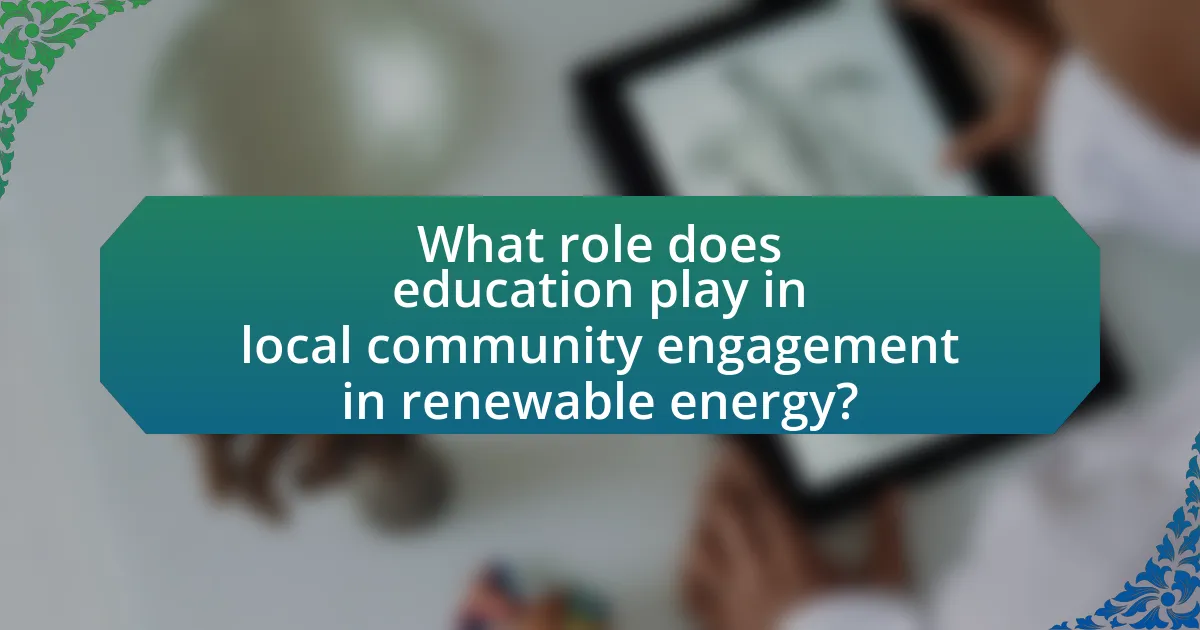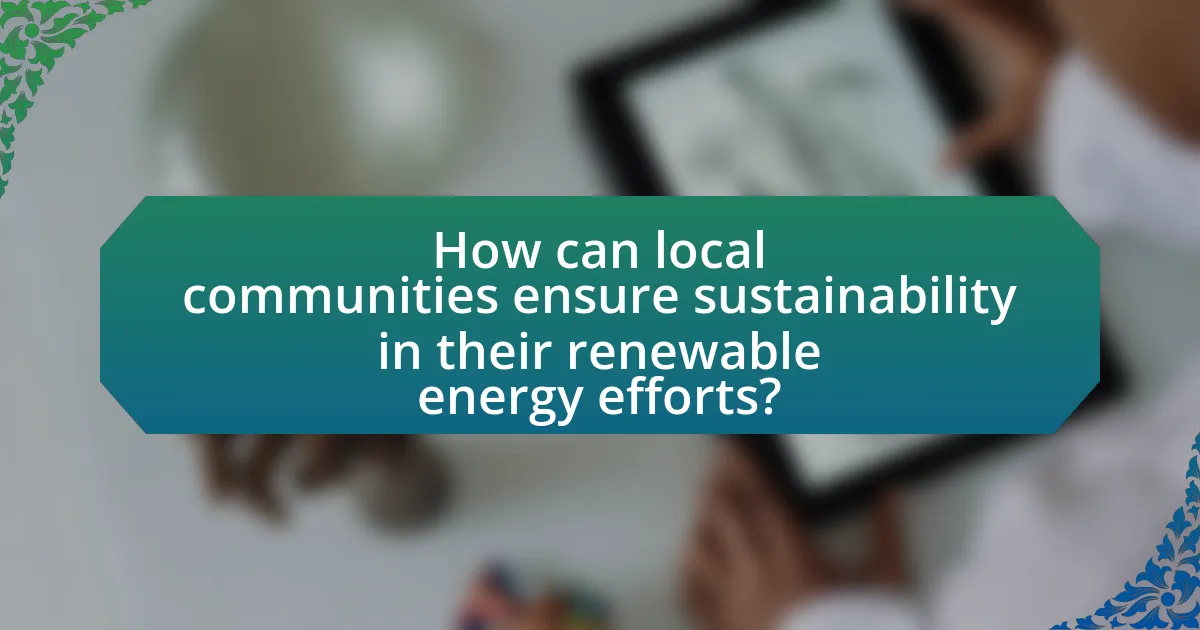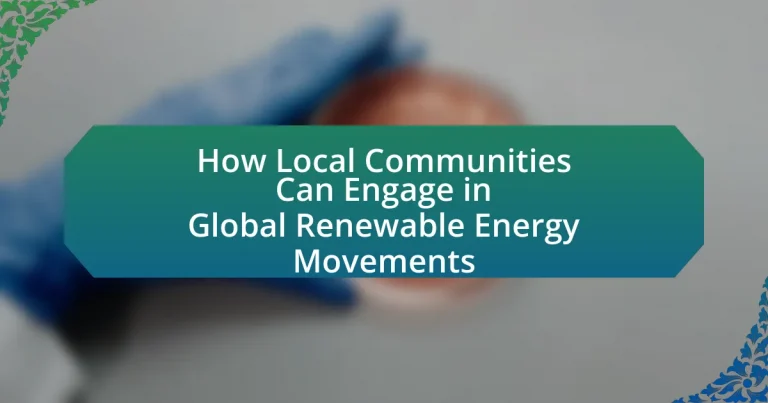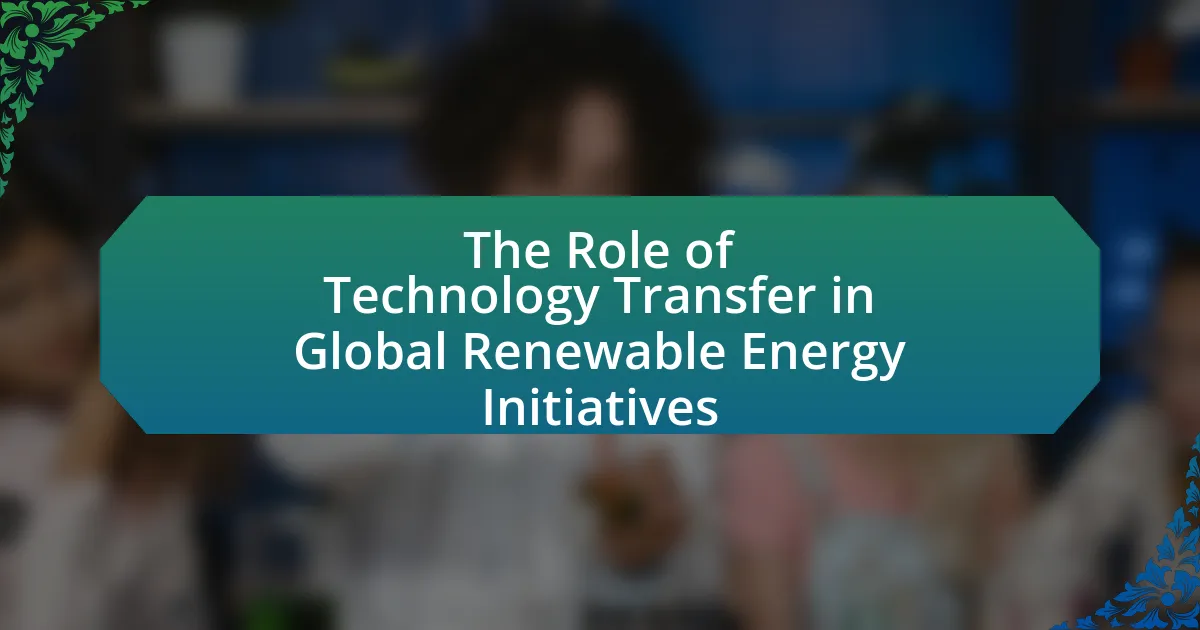Local communities play a vital role in advancing global renewable energy movements through localized projects such as solar panels and wind turbines, which reduce fossil fuel dependence and promote sustainability. Key motivations for community engagement include enhancing energy independence, lowering costs, and creating local jobs. The article explores the importance of local involvement for the success of renewable initiatives, the benefits communities gain from participation, and strategies for effective engagement, including education and collaboration with grassroots organizations and local governments. Additionally, it addresses challenges faced by communities, misconceptions about renewable energy, and best practices for sustaining projects, highlighting the significance of community-led efforts in achieving sustainable energy goals.

How can local communities contribute to global renewable energy movements?
Local communities can contribute to global renewable energy movements by implementing localized renewable energy projects, such as solar panels and wind turbines, which reduce reliance on fossil fuels and promote sustainable practices. These initiatives not only lower carbon emissions but also create local jobs and stimulate economic growth. For instance, a study by the International Renewable Energy Agency (IRENA) found that renewable energy jobs reached 11.5 million globally in 2018, with many of these positions arising from community-led projects. Additionally, local communities can advocate for policy changes that support renewable energy development, thereby influencing broader governmental and corporate strategies towards sustainability.
What are the key motivations for local communities to engage in renewable energy initiatives?
Local communities engage in renewable energy initiatives primarily to enhance energy independence and reduce reliance on fossil fuels. This motivation is driven by the desire to lower energy costs, as renewable sources like solar and wind can provide cheaper long-term energy solutions. Additionally, communities aim to mitigate environmental impacts, as renewable energy reduces greenhouse gas emissions and pollution. Economic benefits also play a crucial role; local renewable projects can create jobs and stimulate local economies. For instance, a study by the National Renewable Energy Laboratory found that community solar projects can generate significant local employment opportunities, further incentivizing community involvement in renewable energy initiatives.
Why is local involvement crucial for the success of global renewable energy movements?
Local involvement is crucial for the success of global renewable energy movements because it ensures that initiatives are tailored to the specific needs and contexts of communities. Engaging local stakeholders fosters ownership, increases acceptance, and enhances the effectiveness of renewable energy projects. For instance, studies show that projects with local participation have a 30% higher success rate in implementation compared to those without. Additionally, local knowledge can lead to innovative solutions that are more sustainable and culturally appropriate, further driving the success of global efforts in renewable energy adoption.
How do local communities benefit from participating in renewable energy projects?
Local communities benefit from participating in renewable energy projects through economic growth, job creation, and enhanced energy security. By engaging in these projects, communities can stimulate local economies, as investments in renewable energy often lead to the development of infrastructure and services. For instance, a study by the International Renewable Energy Agency (IRENA) found that renewable energy projects can create up to 24 million jobs globally by 2030, significantly impacting local employment rates. Additionally, renewable energy projects reduce reliance on imported fossil fuels, thereby increasing energy independence and stability for communities. This dual advantage of economic and energy benefits illustrates the tangible gains local communities can achieve through their involvement in renewable energy initiatives.
What strategies can local communities adopt to engage in renewable energy movements?
Local communities can adopt strategies such as forming cooperative energy initiatives, advocating for local renewable energy policies, and organizing educational campaigns to engage in renewable energy movements. Cooperative energy initiatives allow community members to collectively invest in renewable projects, which can lead to shared benefits and increased local energy independence. Advocating for local policies can involve lobbying for incentives or regulations that support renewable energy development, thereby creating a more favorable environment for such initiatives. Educational campaigns raise awareness about the benefits of renewable energy, encouraging community participation and fostering a culture of sustainability. These strategies have been shown to enhance community involvement and drive the transition to renewable energy sources effectively.
How can grassroots organizations facilitate community engagement in renewable energy?
Grassroots organizations can facilitate community engagement in renewable energy by organizing local initiatives that educate residents about sustainable practices and renewable technologies. These organizations often conduct workshops, informational sessions, and community meetings to raise awareness about the benefits of renewable energy, such as cost savings and environmental impact. For example, a study by the National Renewable Energy Laboratory found that community-based programs significantly increase public support for renewable energy projects, leading to higher participation rates. By fostering a sense of ownership and collaboration, grassroots organizations empower community members to advocate for renewable energy solutions tailored to their specific needs and contexts.
What role do local governments play in supporting renewable energy initiatives?
Local governments play a crucial role in supporting renewable energy initiatives by implementing policies, providing funding, and facilitating community engagement. They create local regulations that promote the installation of renewable energy systems, such as solar panels and wind turbines, often through zoning laws and building codes that favor sustainable practices. Additionally, local governments may offer financial incentives, such as grants or tax rebates, to encourage residents and businesses to adopt renewable energy technologies. For instance, a study by the National Renewable Energy Laboratory found that local policies significantly influence the adoption rates of solar energy, demonstrating the effectiveness of local government actions in promoting renewable energy.
What challenges do local communities face when engaging in renewable energy movements?
Local communities face several challenges when engaging in renewable energy movements, including financial constraints, lack of technical expertise, and regulatory barriers. Financial constraints often limit the ability of communities to invest in renewable technologies, as initial capital costs can be high. Additionally, many local communities may lack the technical expertise required to implement and maintain renewable energy systems, leading to reliance on external consultants or companies. Regulatory barriers, such as complex permitting processes and restrictive zoning laws, can further hinder the development of renewable energy projects. These challenges collectively impede the ability of local communities to effectively participate in and benefit from renewable energy initiatives.
How can financial constraints hinder local renewable energy projects?
Financial constraints can significantly hinder local renewable energy projects by limiting access to necessary capital for development and implementation. Without sufficient funding, communities may struggle to cover initial costs such as technology acquisition, installation, and maintenance of renewable energy systems. For instance, a study by the International Renewable Energy Agency (IRENA) found that financial barriers are among the top challenges faced by local renewable energy initiatives, with many projects failing to launch due to inadequate investment. Additionally, limited financial resources can restrict the ability to conduct feasibility studies, which are essential for assessing the viability of renewable energy projects. This lack of financial backing ultimately stifles innovation and slows the transition to sustainable energy solutions at the local level.
What are the common misconceptions about renewable energy in local communities?
Common misconceptions about renewable energy in local communities include the belief that renewable energy sources are unreliable and that they require excessive land use. Many people think that solar and wind energy cannot provide consistent power, despite studies showing that advancements in technology and energy storage have significantly improved reliability. Additionally, there is a misconception that renewable energy installations, such as wind farms and solar panels, consume vast amounts of land; however, research indicates that these systems can often be integrated into existing landscapes, such as rooftops and agricultural areas, minimizing their footprint.
How can local communities collaborate with global organizations for renewable energy?
Local communities can collaborate with global organizations for renewable energy by forming partnerships that leverage local knowledge and resources while accessing global expertise and funding. These collaborations can take the form of joint projects, where communities implement renewable energy solutions such as solar or wind power, supported by global organizations that provide technology, training, and financial assistance. For instance, the Global Solar Council has worked with local entities to deploy solar energy systems in underserved areas, demonstrating the effectiveness of such partnerships. Additionally, local communities can participate in global initiatives like the United Nations’ Sustainable Energy for All, which encourages local engagement in global energy goals, ensuring that local voices are heard in the development of renewable energy strategies.
What are the best practices for local communities to implement renewable energy solutions?
Local communities can effectively implement renewable energy solutions by prioritizing community engagement, conducting feasibility studies, and leveraging available funding sources. Engaging the community ensures that the needs and preferences of residents are considered, fostering support for renewable projects. Feasibility studies help identify the most suitable renewable energy technologies, such as solar, wind, or biomass, based on local resources and conditions. Additionally, communities can access various funding opportunities, including government grants and private investments, to support the financial aspects of renewable energy projects. For instance, the U.S. Department of Energy offers grants specifically for community-based renewable energy initiatives, which can significantly reduce the financial burden on local governments and organizations.
How can local communities measure the impact of their renewable energy initiatives?
Local communities can measure the impact of their renewable energy initiatives by tracking key performance indicators such as energy production, cost savings, and carbon emissions reductions. For instance, communities can install monitoring systems to quantify the amount of energy generated from solar panels or wind turbines, which provides data on the effectiveness of these initiatives. Additionally, surveys can be conducted to assess community awareness and acceptance of renewable energy projects, while financial analyses can reveal savings on energy bills. According to the U.S. Department of Energy, communities that implement renewable energy projects can reduce greenhouse gas emissions by an average of 30% over a decade, demonstrating the tangible benefits of such initiatives.
What resources are available for local communities to enhance their renewable energy efforts?
Local communities can enhance their renewable energy efforts through various resources such as government grants, technical assistance programs, and community-based organizations. Government grants, like those from the U.S. Department of Energy, provide funding for renewable energy projects, enabling communities to invest in solar, wind, and other sustainable technologies. Technical assistance programs, often offered by state energy offices or non-profits, help communities with project planning, implementation, and management. Additionally, organizations like the Renewable Energy and Energy Efficiency Partnership (REEEP) offer resources and networking opportunities to support local initiatives. These resources collectively empower communities to adopt and expand renewable energy solutions effectively.

What role does education play in local community engagement in renewable energy?
Education plays a crucial role in local community engagement in renewable energy by increasing awareness and understanding of sustainable practices. Through educational programs, communities gain knowledge about the benefits of renewable energy sources, such as solar and wind, which can lead to increased adoption and support for local initiatives. For instance, studies show that communities with educational outreach programs are more likely to implement renewable energy projects, as informed citizens are better equipped to advocate for and participate in these initiatives. This engagement is further supported by data indicating that educational workshops and seminars can significantly enhance community participation rates in renewable energy projects, fostering a culture of sustainability and collective action.
How can educational programs raise awareness about renewable energy?
Educational programs can raise awareness about renewable energy by integrating comprehensive curricula that focus on the science, benefits, and applications of renewable energy sources. These programs can include hands-on activities, workshops, and community projects that engage students and local residents in practical experiences, such as building solar panels or participating in wind energy demonstrations. Research indicates that experiential learning significantly enhances understanding and retention of information, making it more likely that participants will advocate for renewable energy solutions in their communities. For instance, a study by the National Renewable Energy Laboratory found that educational initiatives that involve community participation can increase public support for renewable energy projects by up to 50%.
What types of educational initiatives are most effective in local communities?
Community-based educational initiatives that focus on renewable energy awareness and practical skills are most effective in local communities. Programs such as workshops on solar panel installation, energy efficiency practices, and local sustainability projects empower residents with knowledge and hands-on experience. Research indicates that initiatives like the Solar Energy International’s training programs have successfully increased local engagement in renewable energy projects, leading to a 20% increase in solar installations in participating communities. Additionally, partnerships with local schools to integrate renewable energy topics into the curriculum have proven effective, as evidenced by the National Renewable Energy Laboratory’s findings that educational outreach increases community participation in energy-saving behaviors by 30%.
How can schools and universities partner with local communities for renewable energy education?
Schools and universities can partner with local communities for renewable energy education by developing collaborative programs that integrate community needs with academic resources. These partnerships can include joint workshops, internships, and research projects focused on local renewable energy initiatives, allowing students to engage directly with community members and stakeholders. For instance, a study by the National Renewable Energy Laboratory highlights that educational institutions can facilitate community solar projects, providing hands-on learning experiences while promoting sustainable practices. Such collaborations not only enhance educational outcomes but also empower communities to adopt renewable energy solutions effectively.
What is the significance of community-led renewable energy projects?
Community-led renewable energy projects are significant because they empower local populations to take control of their energy sources, leading to increased energy independence and sustainability. These projects often result in reduced greenhouse gas emissions, as they typically utilize clean energy technologies such as solar, wind, and biomass. For instance, a study by the International Renewable Energy Agency (IRENA) found that community energy initiatives can reduce carbon emissions by up to 30% in participating areas. Additionally, these projects foster local economic development by creating jobs and keeping energy expenditures within the community, which can stimulate local economies.
How do community-led projects differ from larger, corporate-led initiatives?
Community-led projects prioritize local needs and participation, while larger corporate-led initiatives focus on profit and scalability. Community-led projects often involve grassroots involvement, fostering local ownership and tailored solutions that reflect specific community contexts. In contrast, corporate-led initiatives typically implement standardized solutions aimed at maximizing efficiency and return on investment, often neglecting local nuances. For example, a study by the International Renewable Energy Agency (IRENA) highlights that community energy projects can lead to increased local engagement and empowerment, whereas corporate projects may result in limited community input and potential resistance due to perceived external control.
What success stories exist of community-led renewable energy projects?
Community-led renewable energy projects have seen notable success stories, such as the Samsø Island project in Denmark, which became 100% energy self-sufficient through wind and solar energy. This transformation was achieved by local residents who collectively invested in renewable technologies, resulting in reduced carbon emissions and economic benefits for the community. Another example is the community solar project in the United States, where residents in various states have banded together to create solar farms, allowing those who cannot install solar panels on their properties to benefit from renewable energy. These initiatives demonstrate the effectiveness of community engagement in advancing renewable energy solutions and fostering sustainable practices.

How can local communities ensure sustainability in their renewable energy efforts?
Local communities can ensure sustainability in their renewable energy efforts by implementing community-driven projects that prioritize local resources and needs. Engaging residents in the planning and decision-making processes fosters a sense of ownership and responsibility, which is crucial for long-term commitment. For instance, studies show that community solar projects, where local residents invest in and benefit from solar energy, have higher success rates and sustainability compared to top-down initiatives. Additionally, integrating educational programs about renewable energy can enhance community awareness and participation, leading to more effective and sustainable energy practices.
What practices can local communities adopt to maintain their renewable energy projects?
Local communities can adopt regular maintenance schedules, community training programs, and stakeholder engagement initiatives to maintain their renewable energy projects. Regular maintenance schedules ensure that equipment operates efficiently, reducing downtime and repair costs; for example, wind turbines require periodic inspections and lubrication to function optimally. Community training programs empower local residents with the skills needed to manage and troubleshoot renewable energy systems, fostering a sense of ownership and responsibility. Stakeholder engagement initiatives, such as community meetings and feedback sessions, help address concerns and adapt projects to meet local needs, thereby enhancing project sustainability. These practices collectively contribute to the longevity and effectiveness of renewable energy initiatives within communities.
How can local communities engage in continuous learning and adaptation in renewable energy?
Local communities can engage in continuous learning and adaptation in renewable energy by establishing local energy cooperatives that facilitate knowledge sharing and collaboration. These cooperatives enable community members to participate in workshops, training sessions, and discussions focused on renewable technologies, policies, and best practices. For instance, the Solar Energy International (SEI) offers training programs that empower communities to implement solar energy solutions effectively. Additionally, communities can leverage online platforms and social media to share experiences and innovations, fostering a culture of ongoing education and adaptation. Research indicates that communities actively involved in renewable energy projects report higher levels of satisfaction and resilience, demonstrating the effectiveness of continuous learning in this sector.
What role does community feedback play in sustaining renewable energy initiatives?
Community feedback is crucial for sustaining renewable energy initiatives as it fosters local engagement, enhances project acceptance, and informs decision-making. When communities actively participate in providing feedback, they contribute valuable insights that can lead to better project design and implementation, ensuring that initiatives align with local needs and preferences. Research indicates that projects with strong community involvement are 50% more likely to succeed, as evidenced by case studies in regions like Denmark, where local input has significantly shaped wind energy developments. This collaborative approach not only builds trust but also encourages ongoing support, ultimately leading to the long-term viability of renewable energy projects.
What are the future trends in local community engagement in renewable energy?
Future trends in local community engagement in renewable energy include increased participation in decentralized energy systems, enhanced collaboration through community solar projects, and the integration of digital platforms for education and advocacy. Decentralized energy systems empower communities to generate their own renewable energy, reducing reliance on centralized grids and fostering local resilience. Community solar projects allow residents to invest in shared solar installations, promoting collective ownership and financial benefits. Digital platforms facilitate knowledge sharing and mobilization, enabling communities to advocate for policies that support renewable energy initiatives. These trends reflect a growing recognition of the importance of local involvement in achieving sustainable energy goals.
How can technology enhance local community participation in renewable energy movements?
Technology can enhance local community participation in renewable energy movements by providing platforms for information sharing, facilitating collaboration, and enabling access to funding. Digital tools such as social media and community apps allow residents to share knowledge about renewable energy options, fostering awareness and engagement. For instance, platforms like Nextdoor and Facebook groups enable neighbors to discuss local energy initiatives and organize events. Additionally, technology can streamline collaboration through project management software, allowing community members to coordinate efforts in renewable energy projects effectively. Furthermore, crowdfunding platforms like Kickstarter and GoFundMe provide communities with access to financial resources necessary for implementing renewable energy solutions, evidenced by the success of community solar projects that have raised millions through such platforms.
What emerging partnerships can local communities explore for renewable energy advancements?
Local communities can explore partnerships with renewable energy companies, local governments, and educational institutions to advance renewable energy initiatives. Collaborating with renewable energy companies allows communities to access technology and expertise, as seen in projects like community solar farms, which have been successfully implemented in various regions, providing clean energy and reducing costs. Partnering with local governments can facilitate policy support and funding opportunities, as demonstrated by initiatives like the Solar Energy Innovation Network, which encourages local governments to work together on solar projects. Additionally, engaging with educational institutions can foster research and development, leading to innovative solutions tailored to community needs, as evidenced by university-led projects that have successfully integrated renewable energy systems into local infrastructures.
What practical steps can local communities take to start engaging in renewable energy movements?
Local communities can start engaging in renewable energy movements by forming local energy cooperatives to collectively invest in renewable projects. These cooperatives enable community members to pool resources, share knowledge, and make decisions democratically, fostering a sense of ownership and commitment. For instance, in Germany, over 1,000 energy cooperatives have successfully developed renewable energy projects, contributing to a significant increase in local renewable energy production. Additionally, communities can conduct energy audits to identify potential renewable energy sources, such as solar or wind, and advocate for supportive policies at local government levels. Engaging in educational workshops can also raise awareness about the benefits of renewable energy, encouraging more residents to participate in initiatives.



